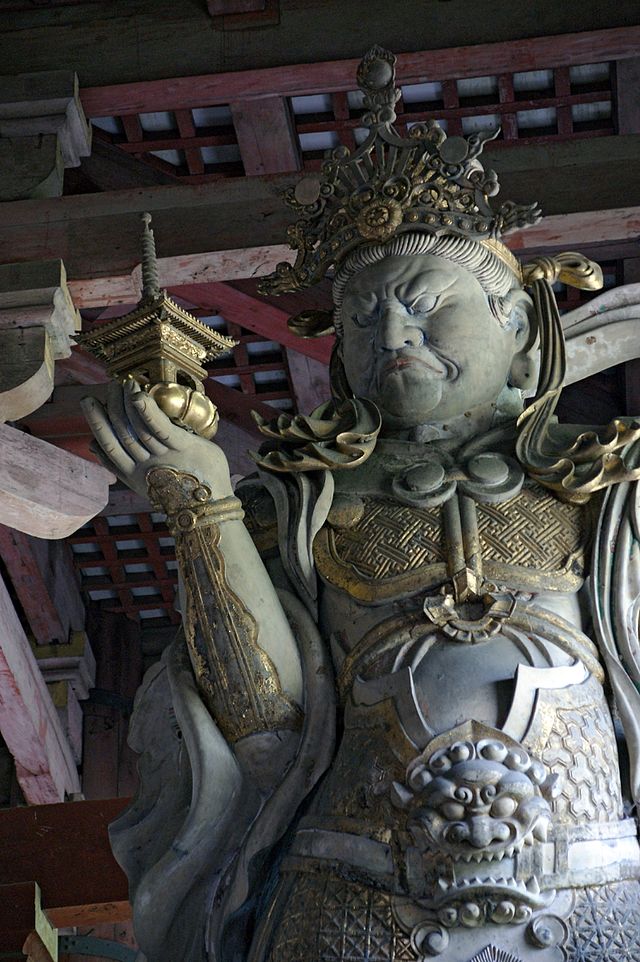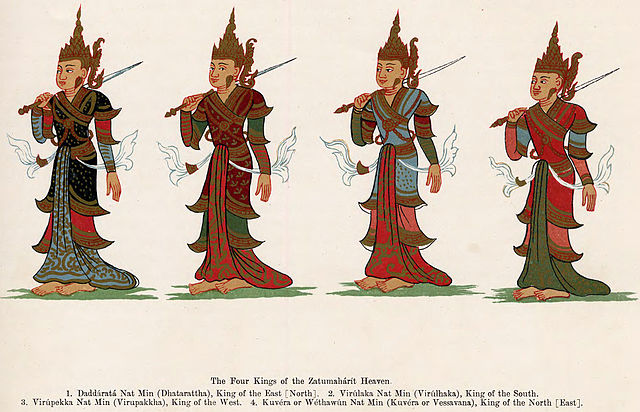Loading AI tools
Buddhist gods From Wikipedia, the free encyclopedia
The Four Heavenly Kings are four Buddhist gods or devas, each of whom is believed to watch over one cardinal direction of the world. The Hall of Four Heavenly Kings is a standard component of Chinese Buddhist temples.
This article has multiple issues. Please help improve it or discuss these issues on the talk page. (Learn how and when to remove these messages)
|


The Kings are collectively named as follows:
| Language | Written form | Romanization | Translation |
|---|---|---|---|
| Sanskrit | चतुर्महाराज | Chaturmahārāja Chaturmahārājikā |
Four Great Kings |
| लोकपाल | Lokapāla | Guardians of the World | |
| Sinhala | සතරවරම් දෙවිවරු | Satharawaram Dewi | Four Privileged/Bestowed Gods |
| Burmese | စတုလောကပါလ စတုမဟာရာဇ်နတ် |
IPA: [sətṵ lɔ́ka̰ pàla̰] IPA: [sətṵ məhà ɹɪʔ naʔ] |
Loanword from catulokapāla loanword from catumahā + king nats |
| Chinese | 天王 | Tiānwáng | Heavenly Kings |
| 四天王 | Sìtiānwáng | Four Heavenly Kings | |
| 四大天王 | Sìdà Tiānwáng | Four Great Heavenly Kings | |
| 风调雨顺/風調雨順 | Fēng Tiáo Yǔ Shùn | Good, rainy weather for growing crops | |
| Japanese | 四天王 | Shi Tennō | Four Heavenly Kings |
| 四大天王 | Shidai Tennō | Four Great Heavenly Kings | |
| Korean | 四天王/사천왕 | Sa-cheonwang | Four heavenly kings |
| Vietnamese | 四天王 | Tứ Thiên Vương | Four heavenly kings |
| 四大天王 | Tứ Đại Thiên Vương | Four great heavenly kings | |
| Tagalog | ᜀᜉᜆ᜔ᜈᜑᜇᜒ
ᜐᜎᜅᜒᜆ᜔ |
Apat na Hari sa Langit | Four heavenly kings |
| Tibetan | རྒྱལ༌ཆེན༌བཞི༌ | rgyal chen bzhi | Four great kings |
| Mongolian | ᠢᠵᠠᠭᠤᠷ ᠤ᠋ᠨ ᠳᠤᠷᠪᠠᠨ ᠶᠡᠬᠡ ᠬᠠᠭᠠᠨ Язгуурун дөрвөн их хаан |
Yazguurun dörwön ix xaan (Ijaɣur-un dörben yeke qaɣan) | Four great kings of the root |
| ᠳᠥᠷᠪᠡᠨ ᠮᠠᠬᠠᠷᠠᠨᠽᠠ
Дөрвөн махранз |
Dörwön maxranz (Dörben maqaranza) | Four great kings, loan word from mahārāja (Sanskrit)/mahārājan (Pali) | |
| ᠣᠷᠴᠢᠯᠠᠩ ᠢ ᠬᠠᠮᠠᠭᠠᠯᠠᠬᠤ ᠳᠥᠷᠪᠡᠨ ᠮᠠᠬᠠᠷᠠᠨᠽᠠ
Орчлоныг хамгаалах дөрвөн махранз |
Orchlonig xamgaalax dörwön maxranz
(Orčilang-i qamaɣalaqu dörben maqaranza) |
World-protecting four great kings | |
| Thai | จาตุมหาราชา | Chatumaharacha | Four Great Kings, loan word from catumahārāja (Pali) |
| จตุโลกบาล | Chatulokkaban | Four Guardians of the World, loan word from catulokapāla (Pali) | |
| Pali | Catu-Mahārāja | Catu-Mahārāja | The Four Great Kings |
Individually, they have different names and features.
| Pali name | Vessavana | Virūlhaka | Dhatarattha | Virūpakkha |
| Devanagari Sanskrit romanization |
वैश्रवण (कुबेर) Vaiśravaṇa (Kubera) |
विरूढक Virūḍhaka |
धृतराष्ट्र Dhṛtarāṣṭra |
विरूपाक्ष Virūpākṣa |
| Meaning | He who hears everything | He who causes to grow | He who upholds the realm | He who sees all |
| Control | yakkhas | kumbhandas | gandhabbas | nagas |
| Description | This is the chief of the four kings and protector of the north. He is the ruler of rain. His symbolic weapons are the umbrella or pagoda. Wearing heavy armor and carrying the umbrella in his right hand, he is often associated with the ancient Hindu god of wealth, Kubera. Associated with the color yellow or green. | King of the south and one who causes good growth of roots. He is the ruler of the wind. His symbolic weapon is the sword which he carries in his right hand to protect the Dharma and the southern continent. Associated with the color blue. | King of the east and god of music. His symbolic weapon is the pipa (stringed instrument). He is harmonious and compassionate and protects all beings. Uses his music to convert others to Buddhism. Associated with the color white. | King of the west and one who sees all. His symbolic weapon is a snake or red cord that is representative of a dragon. As the eye in the sky, he sees people who do not believe in Buddhism and converts them. His ancient name means "he who has broad objectives". Associated with the color red |
| Image |  |
 |
 |
 |
| Color | yellow or green | blue | white | red |
| Symbol | umbrella | sword | pipa | serpent |
| mongoose | stupa | |||
| stupa | pearl | |||
| Followers | yakṣas | kumbhāṇḍas | gandharvas | nāgas |
| Direction | north | south | east | west |
| Traditional/Simplified Chinese Pinyin |
多聞天王 / 多闻天王 Duōwén Tiānwáng |
增長天王 / 增长天王 Zēngzhǎng Tiānwáng |
持國天王 / 持国天王 Chíguó Tiānwáng |
廣目天王 / 广目天王 Guăngmù Tiānwáng |
| 毗沙門天 / 毗沙门天 | 留博叉天 / 留博叉天 | 多羅吒天 / 多罗吒天 | 毗琉璃天 / 毗琉璃天 | |
| Kanji Hepburn romanization |
多聞天 (毘沙門天) Tamon-ten (Bishamon-ten) |
増長天 Zōchō-ten |
持国天 Jikoku-ten |
広目天 Kōmoku-ten |
| 治国天 Jikoku-ten | ||||
| Hangul romanized Korean |
다문천왕 Damun-cheonwang |
증장천왕 增長天王 Jeungjang-cheonwang |
지국천왕 持國天王 Jiguk-cheonwang |
광목천왕 廣目天王 Gwangmok-cheonwang |
| Vietnamese alphabet Chữ Hán |
Đa Văn Thiên Vương 多聞天王 |
Tăng Trưởng Thiên Vương 增長天王 |
Trì Quốc Thiên Vương 持國天王 |
Quảng Mục Thiên Vương 廣目天王 |
| Filipino alphabet Baybayin |
Bisrabana ᜊᜀᜒᜐᜀᜊᜀᜈᜀ |
Birudhaka ᜊᜒᜓᜇᜑᜀᜃᜀ |
Dhltalastla ᜇᜑᜎᜆᜑᜀᜎᜀᜐᜆᜎᜀ |
Bilupaksa ᜊᜒᜎᜓᜉᜀᜃᜐᜀ |
| Burmese Script | ဝေဿဝဏ္ဏနတ်မင်း (Waithawun Nat Min) ကုဝေရနတ်မင်း (Kuwaira Nat Min) |
ဝိရူဠကနတ်မင်း (Wirulakka Nat Min) | ဓတရဋ္ဌနတ်မင်း (Datarattha Nat Min) | ဝိရူပက္ခနတ်မင်း (Wirupakkha Nat Min) |
| Tibetan alphabet and romanization | རྣམ་ཐོས་སྲས་ (Namthöse) | ཕགས་སྐྱེས་པོ་ (Phakyepo) | ཡུལ་འཁོར་སྲུང་ (Yülkhorsung) | སྤྱན་མི་བཟང་ (Chenmizang) |
| Mongolian Script and Mongolian Cyrillic and Mongolian Latin alphabet | ᠲᠡᠢᠨ ᠰᠣᠨᠣᠰᠤᠭᠴᠢ
(Тийн сонсогч) Tiin sonsogch/tein sonosuɣči |
ᠦᠯᠡᠮᠵᠢ ᠪᠡᠶᠡᠲᠦ
(Үлэмж биет) Ülemzh biyet/Ülemji beyetü |
ᠣᠷᠣᠨ ᠣᠷᠴᠢᠨ ᠢ ᠰᠠᠬᠢᠭᠴᠢ
(Орон орчиниг сахигч) Oron orchinig saxigch/Oron orčin-i sakiɣči |
ᠡᠭᠡᠨᠡᠭᠲᠡ ᠦᠵᠡᠭᠴᠢ
(Эгнэгт үзэгч) Egnegt üzegch/Egenegte üjegči |
| (Намсрай)
Namsrai |
(Пагжийбуу)
Pagzhiibuu |
(Ёлхорсүрэн)
Yolxorsüren |
(Жамийсан)
Zhamiisan | |
| ᠥᠯᠥᠨ ᠦᠨᠳᠡᠰᠲᠨᠢᠢ ᠦᠽᠡᠯ (Олон үндэстний үзэл) Olon ündestnii üzel |
ᠲᠢᠶᠡᠨᠢ ᠥᠰᠥᠯᠲ (Тиений өсөлт) Tiyenii ösölt |
ᠦᠨᠳᠡᠰᠲᠨᠢᠢ ᠽᠠᠰᠤᠠᠷ ᠦᠯᠢᠴᠬᠢᠯᠭᠡᠡ (үндэсний засвар үйлчилгээ) ündesnii zasvar üilchilgee |
ᠰᠶᠡᠯᠶᠡᠰᠲᠢᠶᠡᠯ ᠰᠦᠷᠲᠠᠯᠴᠬᠢᠯᠭᠠᠠ (селестиел сурталчилгаа) syelyestiyel surtalchilgaa | |
| Thai script romanization |
ท้าวเวสวัณ (Thao Wetsawan) ท้าวเวสสุวรรณ (Thao Wetsuwan) ท้าวกุเวร (Thao Kuwen) |
ท้าววิรุฬหก (Thao Wirunhok) | ท้าวธตรฐ (Thao Thatarot) | ท้าววิรูปักษ์ (Thao Wirupak) |
All four Kings serve Śakra, the lord of the devas of Trāyastriṃśa. On the 8th, 14th and 15th days of each lunar month, the Kings either send out emissaries or go themselves to inspect the state of virtue and morality in the world of men. Then they report their findings to the assembly of the Trāyastriṃśa devas.
On the orders of Śakra, the Kings and their retinues stand guard to protect Trāyastriṃśa from another attack by the Asuras, which once threatened to destroy the realm of the devas. They also vowed to protect the Buddha, the Dharma, and the Buddha's followers from danger. In Chinese Buddhism, all four of the heavenly kings are regarded as four of the Twenty Devas (二十諸天 Èrshí Zhūtiān) or the Twenty-Four Devas (二十四諸天 Èrshísì zhūtiān), a group of Buddhist dharmapalas who manifest to protect the Dharma.[1]

According to Vasubandhu, devas born in the Cāturmahārājika heaven are 1/4 of a krośa in height (about 750 feet tall). They have a five-hundred-year lifespan, of which each day is equivalent to 50 years in our world; thus their total lifespan amounts to about nine million years (other sources say 90,000 years).

The attributes borne by each King also link them to their followers; for instance, the nāgas, magical creatures who can change form between human and serpent, are led by Virūpākṣa, represented by a snake; the gandharvas are celestial musicians, led by Dhṛtarāṣṭra, represented with a lute. The umbrella was a symbol of regal sovereignty in ancient India, and the sword is a symbol of martial prowess. Vaiśravaṇa's mongoose, which ejects jewels from its mouth, is said to represent generosity in opposition to greed.
| Vaiśravaṇa
(north) |
||
| Virūpākṣa
(west) |
Heavenly Kings | Dhṛtarāṣṭra
(east) |
| Virūḍhaka
(south) |
Seamless Wikipedia browsing. On steroids.
Every time you click a link to Wikipedia, Wiktionary or Wikiquote in your browser's search results, it will show the modern Wikiwand interface.
Wikiwand extension is a five stars, simple, with minimum permission required to keep your browsing private, safe and transparent.